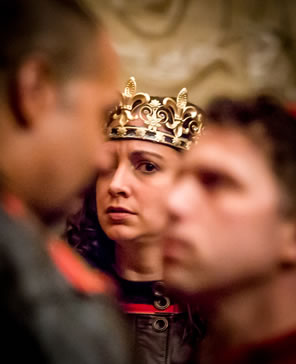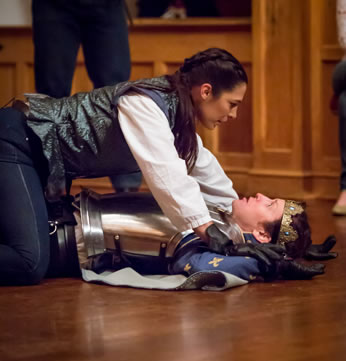Shakespeare's Joan of Arc (Henry VI, Part 1)
Taking Title, Losing Ownership
American Shakespeare Center, Blackfriars Playhouse, Staunton, Virginia
Sunday, September 20, 2015, C–5&6 (front middle stalls)
Directed by Jim Warren

Henry VI (Stephanie Holladay Earl) casts a wary glance at her rivaling relatives, her uncle the Duke of Gloucester (René Thornton Jr., left) and her great uncle the Bishop of Winchester (Gregory Jon Phelps) in the American Shakespeare Center's production of Henry VI, Part One at the Blackfriars Playhouse. Below, Joan of Arc (Abbi Hawk) disarms Charles the Dauphin (Chris Johnston), convincing him she's the real deal. Photos by Tommy Thompson, American Shakespeare Center.
One of my favorite Shakespeareances of all time was the succession of American Shakespeare Center's Wars of the Roses productions (the three parts of Henry VI plus Richard III) at the Blackfriars Playhouse from 2009–2012, each sequel played in succeeding years. Thus, the same company remounting Part One this year became a yearlong anticipation.
Except that ASC billed the play as Shakespeare's Joan of Arc (Henry VI, Part 1), flicking my annoyance nerve. The retitling may be good marketing: Shakespeare's history plays are a tough sell, even though the bulk of them represent some of his best work. However, it also appeared to be a deliberate shirking from the piece's essential being, a chaotic, children's playground of a play by a young Shakespeare still getting his stage legs as a playwright. Notwithstanding brilliant performances from the two title characters, that psychological underpinning plays a factor in what turns out to be a listless production that doesn't live up to my memory of ASC's 2009 presentation of the play.
Granted, the productions were staged under completely contrary approaches. In 2009, Henry VI, Part One, was part of the Actors' Renaissance Season, in which the troupe of players, without a director or design team, stage five plays over three months, using only queue scripts (their parts plus queue lines) and just days of rehearsals. That is the method Shakespeare's own company apparently used, and seldom is the fit of script and method so apt as with Shakespeare's earliest plays, especially Henry VI, Part One. The play is riotous good fun and melodramatic tragedy, with so many characters coming and going we lose track of who's who, but it doesn't matter. We just know who is English, who is French, who is Yorkist, and who is Lancastrian—well, that second white rose-red rose pairing gets a little confusing, but that's part of the madness.
This year's production of Henry VI, Part One, has a director: Jim Warren, who is a master of text-centric Shakespeare and, as co-founder and artistic director of the American Shakespeare Center, almost always gets the most singular theater experiences out of the play space that is the Blackfriars Playhouse, the world's only replica of Shakespeare's indoor theater. This year's production has a design team: Costume Designer Jennifer C. Bronsted, who dresses the company in modern-style medievalry, combining jeans and leather pants with jerkins and armor for the men while the ladies wear classic Renaissance gowns; and Properties Master Christopher Moneymaker, who festoons the playhouse with red rose and white rose vines and heraldic placards, red and blue banners, real candles, and the Plantagenet flag of fleur de lis and lions in place of the theater's normal backstage curtain. This production also came together over several weeks of rehearsal.
Yet, this production lacks spark. It has some humorous interpolations, such as the Chariots of Fire theme playing to bide the time for Reignier (Patrick Midgley), Margaret's father, to descend from upper stage to lower to meet with the Earl of Suffolk, played by Patrick Earl, who gives a sly glance to the audience when he tells Margaret, "An earl I am." However, the whole lacks the frantic fun of the just-do-it aesthete of the 2009 production. Thematic elements are carefully considered and plotted in this staging, something the 2009 production didn't have the time to do. Yet, many in this cast don't delineate their individual characters enough to clear up who's who, and there's no this-is-crazy attitude of the 2009 staging to gloss the confusion.
The lesson in this, given the similar talent pedigree behind both versions, is an ironic reiteration of ASC's stated mission: staging Shakespeare as Shakespeare himself staged Shakespeare makes for the best Shakespeare (best in terms of understanding the plays as well as in entertainment value). Not all Ren Season Shakespeare productions are demonstrably better than their more carefully contrived summer/fall season counterparts, but for a slapdash text like Henry VI, Part One, original practice is inherent in its brilliance.
Still, there is much to credit in this production, and top of the list is Abbi Hawk as Joan La Pucelle, aka Joan of Arc. Joan is a saint to the French but a witch to the English. In a composition of obvious patriotic fervor, you'd expect Shakespeare to play up the occult angle of the character, which he does. But this play also takes a damning look at the self-centered egos of the English ruling class; so, even at this early stage of his career, Shakespeare is presenting political and moral conundrums rather than clear paths of conscience. Joan is no exception. She's an endearing character for the first half of the play, and to me it's notable that the only one on the French side who casts aspersions on the French is Joan herself—Shakespeare essentially admitting that she has some affinity with the English.
Hawk dives into Joan to play all her conundrums convincingly. She not only has the power of a visionary and the skills of a combat veteran, she has assumed the aura of leadership, able to convince an army of men to follow her to victory, whether it's a full-on military assault or subterfuge. Hawk is ebullient and spirited in the early stages, patronizing to both the French and English when the moment suits it, and irritable when the French lords screw up. This production plays Shakespeare's hint that Joan and the Dauphin are lovers as just that—a hint: when the French are roused from their beds in a surprise attack by the English, Joan and Dauphin (Chris Johnston, who plays the crown prince as being in lust with Joan from the moment he meets her) emerge together, but he's in boxer shorts while she's fully clothed. This production also gives a thrilling rendition of the fiends from hell leaving Joan's employ, the faceless demons in head-to-toe body suits and ragged hooded cloaks defying Joan, dissipating her aura of leadership. Hawk's crowning moment comes at Joan's lowest point, her last scene when, under York's arrest, her delusions of grandeur crumble in fits of increasing desperation. Though Shakespeare was writing about England's great national tragedy, the Wars of the Roses, Hawk turns this play into the tragedy of Joan, meriting to some degree the theater's chosen title for the production.
The play's title in the First Folio, though, is The First Part of Henry VI, and bringing to life the tragedy of that title character is Stephanie Holladay Earl. Playing the young, innocent English king as a teen surrounded by barely scrupulous lords, Holladay Earl balances Henry's desire for gravitas with his simple inability to be so, due to his lack of maturity and political experience. We see in her nervous smiles and uncertain starts to her speeches a King Henry in the twain between regarding royal life as a game and grasping real responsibility. Only an actress of Holladay Earl's skills can give such a wavering performance so adroitly.
Not for a moment does Henry realize the dangers of his own kin and kind closing in on him. "Good Lord, what madness rules in brainsick men, when for so slight and frivolous a cause such factious emulations shall arise!" he says, and Holladay Earl speaks this line in naive incredulity, her smile offering no subtext other than the fact that her Henry finds such silliness so amusing. The silliness, though, is the two servants fighting over the color of roses, and two things go tragically wrong for Henry immediately upon her speaking these lines. First, Richard Plantagenet, newly knighted as Duke of York (John Harrell), steps in front of the throne-perched king to issue commands to the court; Holladay Earl's Henry reacts with bafflement rather than anger at York's presumptuous behavior. Then, intending to mitigate the strife, Henry tries to impress on all the lords that a rose by any color smells as sweet as another, and rather than plucking both roses, he picks one: red. Does York's audacity somehow lead Henry to not pick the white? That's not spelled out here, but it crosses our mind as we watch Holladay Earl make her seemingly innocuous choice while we note Harrell's York seething at the side.
 Another key character in Part One is Lord Talbot, the scourge of France, whose mere name causes Frenchmen to flee in fear. James Keegan takes on this two-dimensional character and plays the part's heroic rhetoric to the hilt. It's the right call, because such unwavering nobility and heroism is more poignantly set apart from the petty rivalry between York and Somerset (Sarah Fallon) and their personal ambitions that eventually undermine Talbot's army, leading to his death and, ultimately, England's loss of all France. Midgley as Sir William Lucy pleading for the lords to send Talbot resources and reinforcements rings the toll of so many men of service over the years, thwarted in their patriotism by self-serving politicians.
Another key character in Part One is Lord Talbot, the scourge of France, whose mere name causes Frenchmen to flee in fear. James Keegan takes on this two-dimensional character and plays the part's heroic rhetoric to the hilt. It's the right call, because such unwavering nobility and heroism is more poignantly set apart from the petty rivalry between York and Somerset (Sarah Fallon) and their personal ambitions that eventually undermine Talbot's army, leading to his death and, ultimately, England's loss of all France. Midgley as Sir William Lucy pleading for the lords to send Talbot resources and reinforcements rings the toll of so many men of service over the years, thwarted in their patriotism by self-serving politicians.
Taking this installment in isolation, Joan, Henry, and Talbot are the characters who may matter most. However, if you know what's coming in the sequels—and, hopefully, the next three summer/fall seasons at ASC—the most important character appears on stage in one scene of the fifth act: Margaret of Anjou, hereafter Henry's Queen Margaret and one of Shakespeare's greatest female roles (the only character to last all four plays of the series). Allison Glenzer plays Margaret, and as a member of the 2009–2012 Ren Season troupe (among her many roles she played Eleanor, Duchess of Gloucester in Part Two and Elizabeth of York in Part Three and Richard III), she already is familiar with Margaret's four-play arc. In her brief moment on stage in this installment, we see in her bearing and attitude the greatness and the contention to come.
And as we look around this company, we also have to wonder who among them will appear near the end of the next play as York's son, the "crookback" Richard. That's good for another year's worth of anticipation.
Eric Minton
November 28, 2015
Comment: e-mail editorial@shakespeareances.com
Start a discussion in the Bardroom



 Find additional Shakespeareances
Find additional Shakespeareances